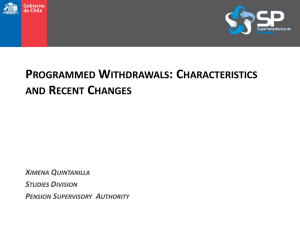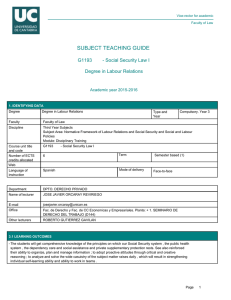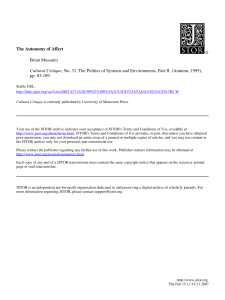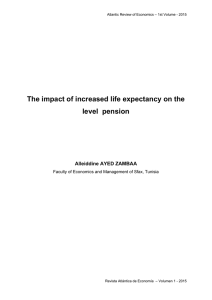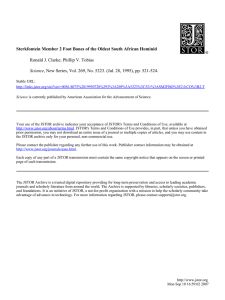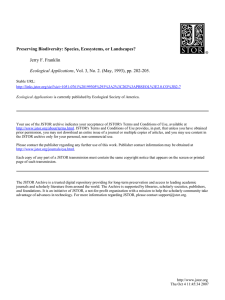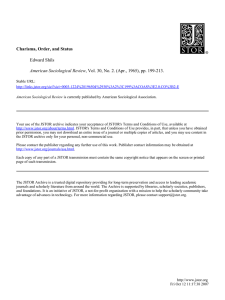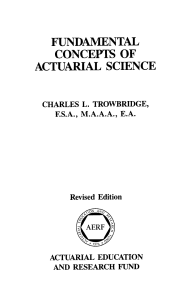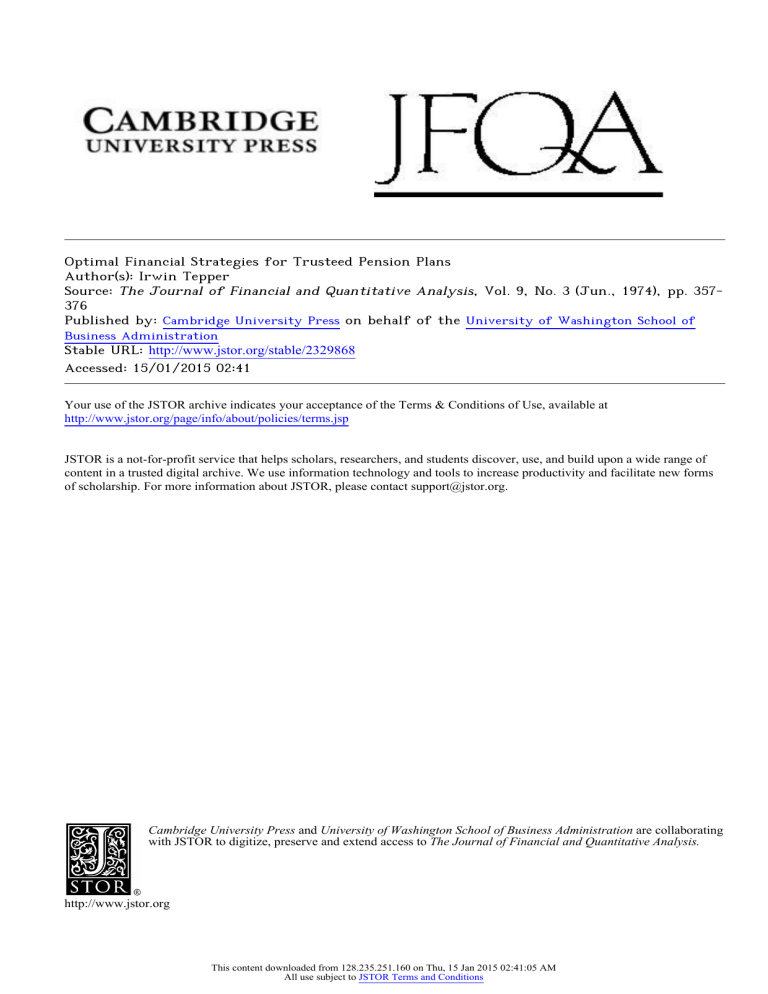
Optimal Financial Strategies for Trusteed Pension Plans
Author(s): Irwin Tepper
Source: The Journal of Financial and Quantitative Analysis, Vol. 9, No. 3 (Jun., 1974), pp. 357376
Published by: Cambridge University Press on behalf of the University of Washington School of
Business Administration
Stable URL: http://www.jstor.org/stable/2329868 .
Accessed: 15/01/2015 02:41
Your use of the JSTOR archive indicates your acceptance of the Terms & Conditions of Use, available at .
http://www.jstor.org/page/info/about/policies/terms.jsp
.
JSTOR is a not-for-profit service that helps scholars, researchers, and students discover, use, and build upon a wide range of
content in a trusted digital archive. We use information technology and tools to increase productivity and facilitate new forms
of scholarship. For more information about JSTOR, please contact support@jstor.org.
.
Cambridge University Press and University of Washington School of Business Administration are collaborating
with JSTOR to digitize, preserve and extend access to The Journal of Financial and Quantitative Analysis.
http://www.jstor.org
This content downloaded from 128.235.251.160 on Thu, 15 Jan 2015 02:41:05 AM
All use subject to JSTOR Terms and Conditions
JOURNAL OF FINANCIAL AND QUANTITATIVE ANALYSIS
June
1974
OPTIMAL FINANCIAL STRATEGIES
FOR TRUSTEED PENSION PLANS
Irwin
I.
Since
minent
the
method
liberalization
bilities
component
rendered
interest
planning.
has
established
of
corporate
institutions
years,
requirements.
in developing
It
*Harvard
of the Faculty
Columbia.
cash
is
fair
These
say
University.
of Commerce
source
have
been
that
management
the
trust
to match
capital
pension
trust
lia-
trusts
has
funds.
to
stimulated
techniques
financial
a pro-
The continuing
in pension
hard-pressed
have
become
as a significant
accumulation
of
has
income.1
contributions
Asset
developments
improved
retirement
pension
outlays.
many firms
pension
and pressures
a major
to
corporate
employees'
provisions
assets
such
for
pension
with
Introduction
Wlorld War the
of provision
of
In recent
funding
Second
Tepper*
analysis
meet
their
a broadly
that
stress
of
pension
This paper was written
when the author
and Business
Administration,
University
plans'
based
strategic
trusts
was a member
of British
This paper is an outgrowth
of the author's
unpublished
Ph.D. dissertation
(15);
the author
is thankful
for the constructive
of the members
suggestions
of the committee.
In addition,
Professors
Gerard Dickinson
and Alex Robichek,
participants
in a seminar
at the Harvard Business
School,
and a referee
provided helpful
comments on an earlier
draft
of this
paper.
1This paper is strictly
devoted
to an analysis
of pension
trusts
as opposed to insured
schemes.
As will
be seen,
and as is normally
the case,
the
pension
plan leading
to the corporate-administered
trust
arrangement
is assumed to be of the defined
benefit
variety
as opposed
to a defined
contribution type.
For descriptions
of these
plan characteristics
see Section
II below and [91,
and (18].
[12],
357
This content downloaded from 128.235.251.160 on Thu, 15 Jan 2015 02:41:05 AM
All use subject to JSTOR Terms and Conditions
at
remains,
This
this
paper
timal
financial
upon
objectives
the
time,
is
ken
for
paramount
the
of
of
the
the
sumptions,
pertains
to
a liability
the
latter
pertains
time
over
preceding
ered
in
in
which
are
and Section
Section
of
all
under
the
II
concerned
which
goal
is
on corporate
as
of
is
opplaced
to be
taken
The
activity.
the
constraining
benefit
stochastic
decision
is
security
programming
to
paper,
the
two areas
ta-
forms
the
to
the
with
the
plan
of
benefit
latter
outputs
are
process
area
taken
is
to
directly
(see
ul-
levels
alluded
as given
actu-
that
method)
not
as-
(in
accumulation
security
- is
policy
and actuarial
a cost
minimum asset
the
the
design
and allocation
selection
of
fundamental
and investment
decisions
valuation
to provide
rather
the
in
dealing
establishment
In this
analysis;
II
area,
needed
paragraph.
the
specific
provision
process
- funding
trusts
decision
results
The focus
viewed
Dynamic
decision
A third
timately
the
deriving
trusts.
outlays
are
for
a model
model.3
pension
jargon,
the
pension
latter,
of
pension
government
stressed.
arial
development
corporation;
importance.
decision
of
side
impact
to
the
corporate
the
and the
regard
Integration
asset
the
labor
With
to be of
basis
of
with
to
and nonquantitative.2
simplistic
for
internal
of
process.
concerned
strategies
minimization
objectives
relatively
in
the
consid-
footnote
2
below).
introduces
parties
pension
trusts
the
are
pension
accounted
are
decision
for
administered
environment.
and the
is
The interests
organizational
discussed.
arrangement
The discretionary
crisis
2References
and [17] attest
to the current
[1],
[4],
[5],
[13],
studies
expectations.
The few rigorous
in corporate
fulfillment
of pension
on the effects
and [20])
tend to concentrate
that do exist
([7],
[16],
[18],
and allocation
decisions
on the valuation
of plan design/actuarial
assumption
(see the following
paragraphs).
of pension
plan liabilities
and uncertainty
literafamiliar
with the multiperiod
3The reader
savinqs
between
the
find a close
similarity
and [14] will
ture
(e.a.
[6],
[8],
[11],
in
in that area and the one formulated
models
structures
of the representative
in the former area have
of optimal
policies
this
study.
Since
the properties
results
will
not be translated
these
to
been derived
in the literature
cited,
the pension
below.
planning
model that is developed
358
This content downloaded from 128.235.251.160 on Thu, 15 Jan 2015 02:41:05 AM
All use subject to JSTOR Terms and Conditions
elements
of
pension
Section
optimal
III
of
the
is
solutions
Section
fund
management
devoted
for
IV is
devoted
pertaining
to
of
the
that
pension
group
benefit
discussion
the
model.
is
presented.
of
the
of
The nature
practical
applicability
results
a plan's
insure
liberalized
Benefit
the
The firm
to
could
cash
interest
plan
plan),
and social
in
the
participants
the
management
practices
current
(i.e.,
the
government,and
firm.
employ-
The ob-
below.
directly
commitments
decide
flows
antee
future
advance
of
its
of
the
the
will
concerned
solely
such as death
some of
the
plan
and
(2)
fringe
negotiations,
determi-
major
participants
strive
increasingly
obtain
firm.5
or accrued,
an increment
benefit
benefit
of
in
directly
pay-as-you-go
payment
be met
is
the
and,
event
from
hence,
of
there
the
made
income.
concurrent
features
approach
of
with the provision
benefits
and disability
5The rationale
for such liberalizations
between
and retirement
employment
income,
to inflation,
and (3) to obtain
response
graded vesting
provisions.
a promise
retirement
future
payments
This
benefit
firm's
the
Labor
established,
operations.
actual
factors.
are
benefits
from
to pay
obligations
paper is
provisions
granted
in
scheme
influences
A credited,
to meet
from
benefit
Once it's
of
an employee
in
4This
Additional
ered.
Environment
from a multiplicity
Factors.
no funding
that
the
are
a retirement
security
benefit
firm
a direct
discussed
initiation.4
Security
by the
of
pressures,
of
Decision
Labor
package
competitive
have
by the
are
The incorporation
future
of
configuration
a brief
plan
covered
each
of
Objectives
(1)
development
The Pension
parties
and retirees
jectives
to
to
identified.
analysis.
The three
nants
the
a particular
II.
ees
to
are
is
firm's
retirement
are not
no quarbankruptcy
income.
consid-
has been (1) to establish
parity
in
benefits
retirement
(2) to adjust
and upretirement
improved earlier
359
This content downloaded from 128.235.251.160 on Thu, 15 Jan 2015 02:41:05 AM
All use subject to JSTOR Terms and Conditions
funding
Firms
liabilities.6
by establishing
ed later
in
this
section.7
this
of
interests
from
arise
discussed
in
the
following.
paribus
tiations,
tions.
process
shared
Losses,
to pension
in
with
on the
it
to
presentsecurity,
benefit
corporate
plan
other
for
benefit
the
reflect
and will
plan
performance
that
such
factors
say
liberalizations
must
of matching
assets
with
liabilities.
of
pension
plan
performance
operations
plan
funding
participants
hand,
into
be incorporated
not
in pension
Improvements
reductions
are
that
guidelines
motivations
effect
will
that
provisions
the
Suffice
asymmetrical
An important
benefit
well-defined
exogeneous
paper.
this
by firms
pated
form of
Many of
influences
in
be seen,
of
provision
the
As will
con-
tax
certain
for
The details
trust.
pension
to pension
value
participants.
plan
Liberalizations.
Benefit
of
the
takes
instance,
can qualify
plans
a registered
in
equal
assets
accumulate
funded
want
that
cessions
in
to
advance
advocated
have
employees
benefits,
accrued
sufficient
levels
at
of
security
To ensure
termination).
plan
pension
therefore,
(and,
are
this
which
levels
are
often,
in
the
form of
the
sole
as
benefit
responsibility
be antici-
on the
is
study
would
be
not
lead
a result
level
the
to
of
ceteris
nego-
liberalizaof
the
firm.
at an
by discounting,
is ascertained
liability
6The value of a pension
stream of benefit
future
the expected
rate of interest,
assumed
(actuarial)
some relation
rate bears
this
Presumably
by that liability.
implied
payments
and is thus affected
portfolio
on the investment
to the return
to be expected
are among the
and withdrawal
disability,
Mortality,
policy.
by investment
future
at the expected
to arrive
assumptions
factors
that enter
as actuarial
of
in the selection
of discretion
Inasmuch as there
are elements
stream.
in the
rate employed
of interest
as in the choice
as well
these
assumtpions
as part of the plan
identified
they are collectively
process,
capitalization
2).
area (see footnote
decision
assumption
design/actuarial
scheme the firm
Under an insured
forms.
7Funded plans
take two basic
Alternacommitments.
incremental
pension
annuities
to match its
purchases
involve
size,
by firms of substantial
adopted
largely
trusteed
plans,
tively,
under the management of the
the accumulation
of a segregated
pool of assets
Further
scheme.
of the latter
firm.
This paper is addressed
to the operation
for tax concessions.
it is assumed that plans qualify
360
This content downloaded from 128.235.251.160 on Thu, 15 Jan 2015 02:41:05 AM
All use subject to JSTOR Terms and Conditions
This
on the
performance
of
part
an
GovernmentRguain
To date,
of
security
for
"unfunded"
liability
funded
in
full.
arise
from either
(1)
past
an exception
to
Firms
deduction
pension
in
normal
the
meet
the
manner,
must
tax
given
are
taxation.
plan
a potentially
attractive
balances.
To prevent
corporate
for
prevent
reasons
status
The tax-free
from
the
other
than
the
of
investment
firms
of
withdrawal
exempt
As
payment
of
require
will
if enacted,
legislation,
9Proposed
the
and to reduce systematically
provisions
so that the plan will
past service
liability
status
and [19]).
([13],
[17],
to
increments
full.9
in
permit
that
on
earnings
re-
portfolio
opportunity
funds,
the
plan
under
benefits.
increase
in value over time at the
liabilities
8Unfunded
at which the liability
the dates
preceding
the interval
because
is decreasing.
payments
in the form of benefit
lized
vesting
funded
funded
previously
from using
pension
service
stemming
concessions
and that
earnings
Past
for
funded
be
liability,
usually
current
to be concurrently
have
must
liberalizations.
liabilities,
nonincreasing
current
from
be funded.
to employees
benefit
retroactive
service
accruals,
current
liability
costs,
or normal
past
plan's
words,
emanate
which
for
a pension
In other
benefits
pension
from pretax
regulations
circumstances,
than
of
value
costs
rate,
requirements
these
pension
idle
interest
do not
the
on unfunded
other
(2)
of
rule
portfolios
temporarily
this
or
service
contributions
fund
makes
turns
for
that
of
current
of
granting
liabilities
service
termed
interest
the
guarantee
to
designed
method,
cost
from sources
the
improve
impaired.
time.
over
plan's
assumed
plan's
the
liabilities
uncredited
often
that
insure
increase
In addition,
at
calculated
past
by the
are
and which
accruals
to
The minimum requirements
in benefits.
not
does
largely
are
concessions
generated
motivation
ocsin
increments
tax
qualification
the
can be somewhat
firm
regulations
government
current
allocations
the
some extent,
to
that,
implies
interdependency
firms to
principal
ultimately
361
This content downloaded from 128.235.251.160 on Thu, 15 Jan 2015 02:41:05 AM
All use subject to JSTOR Terms and Conditions
assumed rate
will
be rea-
liberalize
value of unreach a fully
The viewpoint
firms
could
at
taken
times
in
find
this
it
profitable
future
anticipated
normal
ternal
to
were
below
deductions
are
the
To insure
firm
that
a maximum limit
occurs,
deducted
in
Corporate
financial
source
internal
to
of
the
firm
contributions
relatively
in
in
cases
of
in
to
returns
the
where
concessions,
respect
when after-tax
be earned
amount
should
can adjust
In theory,
the
wherein
as
returns
imperfections
implications
of
have
such
unlimited
exists
in
10Implicit
executives
pension
funding
in-
pension
such
fund.
overfunding
contributions
can be
that
the
match
when the
of
the
conditions
on the
considerable
and the
plan,
Objectives
of
cost
with
could
outlays
the
of
funding
upset
around
of
future
future
uses
planned
pension
lia-
requirements
financial
of
levels
contribution
flexibility
so
is
funds
corporate
planned
level
a given
with
funds
opportunity
trust,
degree
For
conse-
so
that
the
firm
as
an investment
develop.
funding
amounts
sources
Furthermore
a sufficient
an analysis
a minimum.
fluctuations
a minimum.
pension
contributions.
associated
from planned
in
of
be at
uncertainties
paribus
and the
outlays.10
should
times
firm
stream
continually
pension
In practice,
there
these
incorporate
plans
not
to
performance
be at
its
decision,
related
ceteris
should
the
the
Deviations
Therefore,
between
made at
Given
uncertain.
tributions
ther,
on the
is
should
and investment
plans.
does
accelerated
funds,
of
are
low.
bilities
are
level
the
funding,
quence
occur
could
that
imposed
link
pension
firm
The general
are
would
tax
Considerations
primary
that
not
the
to make contributions
This
those
of
because
that,
any one period.
The basic
of
costs.
is
is
paper
problem
pension
the
capital
of
of
limited
funds
difficulty
is the
the development
in the firm,
motivations
can be
fund
are
market,
use.
available
in
looked
compared
to
at
with
capital
some degree,
For example,
at
any point
incorporating
of
exclusion
of trustees,
render
the
in
many of
personal
etc.
362
This content downloaded from 128.235.251.160 on Thu, 15 Jan 2015 02:41:05 AM
All use subject to JSTOR Terms and Conditions
costs.
the
corporation
time.
the
objectives
Furother
of
important
practical
Organizational
Variables
sion
Arrangement
of
trust
types
under
actuary
he is
assumption
economic
picture
losses
and/or
integrating
losses
III
Section
payments
given.
into
below
and the
Further,
overall
responsible
for
further
rise
to
alteration
is
pension
values
that
actuarial
of
attendance
not
A
liabilities.
design
and
the
true
gains
and/
asset
base.
cum actuarial
considered
in
of
and allocations
these
pen-
1
distort
future
the
the
study.
plan
that
The pattern
discussion.
be assumed
of
decisions
model
liability
this
recommending
Decision
of
in
assumptions
give
decision
management
considered
liability-oriented
the
will
are
and the
and allocation
subsequent
for
the
Unrealistic
associated
it
that
systematically
of
Fund Administration
valuation
largely
require
The possibility
plans
the
will
analysis.
assumes
decisions.
will
that
of
effects
capacity,
actuarial
gains
the
the
Pension
traditionally
In this
see
into
The corporation
consulting
or
factors
paper;
future
will
quantities
this
are
benefit
be taken
as
known with
cer-
tainty.
The actuarial,
mination
is
is
process
administered
portfolio
tion
tailed
the
to
decisions
sion
corporate
11The
assets,
related
All
some extent.
to
pension
cash
alternative
as occurs
asset
is
in
a plan
defined
in
the
of
the
concerned
parties,
in
general,
the
firm,
be expected,
sets
selection
over
are
the
the
funding
to
the
that
portfolio
influence
in
consulta-
The de-
guidelines.
left
deter-
liability
selection
integrates
picture
employed
the
ultimately
executive
flow
to
As might
manager,
pertaining
rate
interest
trustee.
investment
A corporate
overall
assumed,
presumably
by the
policy
with
or
latter.
decision
with
the
time.
where the union administers
the pool of
contribution
plans
(see footnote
1).
363
This content downloaded from 128.235.251.160 on Thu, 15 Jan 2015 02:41:05 AM
All use subject to JSTOR Terms and Conditions
pen-
The Decision
III.
model for deriving
gramming decision
gies.
point
to the planned
sequence
related
The Benefit
past
Cn
(3.1)
that
variables
that
discussed
number of factors
These difficulties
(3.1)
in terms of stock
sheet.
of a
incorporation
by the ceteris
in a broader
the fact
Despite
specifica-
paribus
expression
overcome by reformulating
resulting
variables,
of the stock
flow counterparts
balance
below is omitted
are largely
tion.
is,
paribus
in terms of the former,
are specified
the regulations
contains
plan's
to a pension
pertain
require-
VAn + rUn-l
>
(3.1)
hand of inequality
Cn be the
n, the funding
ceteris
II)
(see Section
plan
pension
ment for a qualified
unfunded
plan's
Letting
period.
plan at the end of period
to the pension
The right
normal
of the pension
at the end of the previous
liability
contribution
of interest,
assumed rate
n, and Un-l be the value
in time period
service
VA be the firm's
n
Constraint
Security
Let r be the plan's
costs
designed
security.
benefit
to insure
in a constraint
be incorporated
will
and the government
participants
of the plan
The objectives
of contributions.
be
will
function
the objective
to be the firm,
Taking the focal
strate-
and investment
funding
optimal
pro-
of a dynamic stochastic
to the development
is devoted
This section
Model
of the
specification
requirements.
First,
incorporate
the fact
deviated
allocations.
from that
imbedded in previous
so that
liability
deviates
asset
Minimal levels
on an
actuarial
actual
experience
actuarial
basis.
on an ex post basis
(market)
values
deviate
assumptions
Finally,
and/or
gains
could have
giving
return
rise
from quantities
previously
can be adjusted
364
This content downloaded from 128.235.251.160 on Thu, 15 Jan 2015 02:41:05 AM
All use subject to JSTOR Terms and Conditions
to
on invest-
from the assumed interest
in each period
of contributions
can be employed to
In addition,
since
ex post
period
does not
(3.1)
expression
study,
in a given
funding
can be recognized
ments typically
sumed.
excess
on liabilities
a change in plan
figure
that
liability
match subsequent
losses
to this
and of prime importance
rate
asto off-
set
developments
level
of
benefit
Let
of
in
period
n (i.e.,
market
contributions,
the
pression
implicit
of
pension
and benefit
is
provided
constraints.
stipulation
It
sum of
mitted,
is
Bn'
to divert
It
discussed
final
following
are,
presumably
by expression
(3.3),
the
that
the
firm
The Corporate
Objective
The utilization
function
is
a built-in
conditions.
of
the
in
expected
(2)
of
Mn will
plan
with
ex-
if
into
minimum funding
be greater
regulations
its
of
than
perA
operations.
funds
and leads
to
constraint.
security
deviations
+ Bn -Mn)
to
are
stochastic
the
in
firm's
the
not
rigid
regulations
considered
in
instances,
the
(1)
that
can be readily
attainment
funding
cost
there
once
programming,
criterion
opportunity
function
that
Let
The derivation
starting
withdrawal
exceptions
result
The optimization
an objective
Bn.
would,
pension
II prohibits
dynamic
will
flexibility
As in many other
end
given
this
study.
Function
specified,
(multiperiod)
outlays,
such
the
to making
prior
development
implying
benefit
at
Mn.
quantity
certain
but
-
the
the
time
to pensioners,
that
form of
assets
is,
Cn > max(O,FCVLn
There
that
possible
in Section
target
allocations).
inequality,
conclude
from
fund
liability
at
variable
[15].
funds
(3.3)
of
due
will
quite
FCVLn plus
be able
regulation
ing
of
Cn > FCVLn + Bn
One further
the
level
payments
the
(3.1).
of pension
assets
in
maintaining
level
fund
stock
(3.2)
the
areas,
inequality
funded
FCVLn and the
(3.1),
in
required
value
of
above-mentioned
minimum required
the
Cn,
value
three
security
FCVLn be the
M be the
of
the
taken
of
pension
is
will
in
plans
is
of
employed
in
a strategy,
response
to be the
the
to
providing
changing
minimization
of
the
funding.
considerable
capture
an objective
difficulty
true
a decision
valuation
model
365
This content downloaded from 128.235.251.160 on Thu, 15 Jan 2015 02:41:05 AM
All use subject to JSTOR Terms and Conditions
in
of
structura stream
to yield
is
goals
three
of
By virtue
plan
funding
given
an additive,
a sequence
of
the
are
effects
interactive
The cost
ignored.
a
of
period
single
sum of
discounted
by the
function.
objective
dynamic,
to
itself
among these
a compromise
contributions
be measured
will
lend
would
convey
assumption,
additivity
the
in
elements
between
by assuming
reached
that
(3)
below,
development
In the
application.
practical
and
conclusions,
analytical
simple
relatively
costs.
There
each
two ways
are
in
taken
Let
costs
marginal
V(Cn)
let
the
are
contributions
Since
of
the
funds
where
made at
(3.4)
the
assumption
of
The latter
approach
Cn in period
n,
the
end of
=
N
E
an-l
gradually
firm's
each
V'(Cn )> 0,
where
over
be stationary
the
of
in
is
specification.
convexity
i is
introduction
the
period.
in each
function
cost
a _ (l+i)
factor:
discount
cost
be the
For simplicity,
of
by means
study
this
funds
of
funds
involves
entails
The other
constraints.
maximum funding
increasing
One procedure
can be introduced.
period
of
availability
limited
assumed
the
in which
time.13
internal
V"l(cn)
>0.
B be the
Let
discount
rate.
we have
period,
V(C n)
n=l
where
one
+ is
and N is
dynamic
Let
the
value
the
of
length
programming
the
of
(3.4)
stream
horizon.
Finally,
the
formulation
n = 1 and n = N become
Expression
contribution
the
to
last
follow,
and first
to
at
measured
it
index
is
end of
convenient,
periods
periods'
the
counter
indices,
period
for
the
to
time.
respectively.
becomes
and uncertainsavings
in the multiperiod
assumption
12This is a standard
in
reduction
in a dramatic
resulting
and [14]),
(8],
[11],
ty literature
((6],
(see
to be derived
equations
of the functional
the "dimension"
[10] and [15,
is
under which such an assumption
of the conditions
A discussion
Chap. 3]).
See (15, Appenpaper.
is out of the scope of this
in this
instance
justified
case.
out for the nonadditive
the analysis
to follow
is carried
dix C] wherein
of course,
a different
application,
13In an actual
and would depend upon the
for each period
be specified
of funds in that period.
would
cost function
availability
relative
366
This content downloaded from 128.235.251.160 on Thu, 15 Jan 2015 02:41:05 AM
All use subject to JSTOR Terms and Conditions
N
SN-n V(Cn).
=
(3.5)
-
n=l
The constraints
sion
model
have
(3.3)
and
(3.5)).
enter
the
constraints
model
that
been
specified
in
the
of
structure
the
has
the
virtue
the
funding
of
and investment
In addition
Model.
the
in
a clear
the
of
return
process.
The
and
concessions
tax
of
This
first.
It
contributions.
between
interrelationships
The more realis-
manner.
above,
defined
variables
to
quanti-
desired
pro-
subsequently.
developed
is
version
and complicated,
areas
decision
of
the
of
consideration
structure
with
developed
to maximum deductions
the
providing
assumptions
two stages.
in
is
process
explicit
pertaining
regulations
ignores
A Basic
omits
from a forecast
projection
liability
the
be developed
allocation
dynamic
version
simplified
to
will
model
programming
The dynamic
to yield
structures
that
{FCVLnI
be derived
and actuarial
design
herein
given
is
and must
deci-
the
(expressions
{Bn},
factors
liability
plan
to
inputs
are
two subsections
previous
and benefit
levels
No consideration
the
as given
taken
that
function
of
pension
synthesizes
ties.
tic,
objective
are
employment
highly
and the
The sequences
jected
basic
Strategies
and Investment
Funding
Optimal
are
following
the
necessary:
-knn
p
n
the
rate
gross
(kn).
The portfolio
return
is
to
over
assumed
to
return
are
assumed
cally,
the
there
the
superscript
are
zero
(kn)
costs
period
n-l.
of
gross
there
this
adjustment
exists
although
of
of
a choice
choice).
n and the
runs
rate
counter
of
It
is
portfolio
367
This content downloaded from 128.235.251.160 on Thu, 15 Jan 2015 02:41:05 AM
All use subject to JSTOR Terms and Conditions
not
re-
rates
Periodic
random variable.
only
denotes
period
Counting
the
presentation,
selection
portfolio
end of
the
at
to be independently,
(since
distributed
time
of
be the
is
investment
selected
For simplicity
time.
turn
of
earned
is
on the
identi-
portfolios,
assumed
holdings.
that
economic value
WN(MN)- the optimum (minimum) expected
the pension
operating
an initial
period,
At the end of an arbitrary
level
decision
is made.
from the gross
balance
plus
end of period
investment
period's
(3.6)
Mn-l
described
the valuation
incorporating
WN(MN)= min
{V(CN)
E
+
(
min
(C1)
k2
=
above,
re-
on the net of the prior
At the
benefits.
1, 2, ...,
N.
for a planning
horizon
by expression
min
Ek
PNNk
k
(CN,p N)
(3.7)
n
formula given
+
is faced
must be true:
Bn)Pnn
-
in
conditions
have a new market value
assets
minus concurrent
relation
= (Mn + Cn
of the
planner
the pension
experience
contributions
The model of the process
periods,
return
the following
(n-1)
later,
the
an investment
future
and expected
the plan's
of decisions;
are paid,
n, benefits
is based on the market value
One period
market.
sulting
last
given
in an (N)
period
to the plan,and
liabilities
to the forecast
set
say period
of decisions
The set
the firm and capital
with a similar
(N) periods,
(N) is the initial
is transferred
of contributions
fund in relation
Period
with
horizon.
period
desired
of
plan over an interval
fund (MN).
associated
[NV(C 1)
(CN-1P
3.5
of N
is
+
N-1)
N-1
V(C )]]},
1
P2
where "E" stands
expression
for the expectation
In addition,
(3.3).
from which the choice
function
and optimization
operators.
The additivity
the interspersion
has permitted
problem,
expression
lowing more compact and traditional
and the {Cn} are constrained
define
market opportunities
capital
of {p kn} is made.
n
to the objective
The optimization
operator
(3.7),
recursive
assumption
the set
pertaining
of the expectation
can be restated
in the fol-
dynamic programming formalism
368
This content downloaded from 128.235.251.160 on Thu, 15 Jan 2015 02:41:05 AM
All use subject to JSTOR Terms and Conditions
by
(where MN-1
(3.8)
(MN + CN
=
WN(M)
N) PN
= min
{V(CN)
(CN PNN)
=
W0(M0)
to
subject
the
C
pNN
N = 1,
> max(O,
FCVLn + Bn
Mn)
1,
to be in
pkn constrained
n
market opportunities.
sents
(3.8)
optimal
pension
In general,
of
Selection
sions
of
pattern
ment
of
set
first
the
comprise
N.
...,
of
capital
version
the
of
model
that
repre-
planning.
and investment
funding
a specific
design
of
class
are
decisions
functions
objective
values,
in
and to
optimal
which,
14See
uncertainty
that
decisions
liability
assumptions
strategy
globally
sions
the
(3.9)
the
2,
can
determinate.
mutually
render
these
deci-
separable.14
The plan
set
and
2,..
restrictions:
n
Expressions
[(MN+ CN - BN)p N]]}
[W
0
following
(3.9)
k
+ SE
this
interdependent
Samuelson
area.
area
[14],
would
with
for
prevail
to
corresponds
value
of
in
ignored
that
{FCVLn},
a unique
solution
are
the
funding
selection
decisions
for
example,
the
paper
over
time.
a different
multi-period
involve
this
determine
Each different
funding
expected
cost,
of
plan
the
and investment
counterpart
the
in
369
This content downloaded from 128.235.251.160 on Thu, 15 Jan 2015 02:41:05 AM
All use subject to JSTOR Terms and Conditions
and investWN(MN).
design
A
deci-
policy,
the
saving
and
would
result
An Expanded
will
in
the
minimum value
Decision
Model.
now be expanded
to
of WN(MN).
The model
incorporate
presented
the
tax
in
the
factors
previous
that
subsection
appear
in
Section
II
above.
The following
En -
definitions
the
after-tax
the
decision
quantity
n-l.
after-tax
returns
n.
the
cumulative
the
the
period
decision
Ln
the
this
end of
of
of
this
variable
sarily
to
the
deductions
For
firm
is
a contribution
Cn - tnLn where
Then,
for
the
of
of
It
is
the
is
portfolio
pension
to
equal
corporate
the
are
beginning
at
the
tax
before-
rate
and
equal.
deductions
at
the
by such
factors
as plan
funding
and deduction
end of
design,
is
activity,
the
enter
as
not
of
the
state-of-the-world
additional
to Cn) is
necessary
horizon,
but
description
actually
the
made,
deducted,
n.
addition
in
15Note when Cn = L , i.e.,
amount "written
off,"
tie net
form (l-tn )Cn.
n.
period
exemption,
contributions
each
the
taken
since
state
at
A
variables.
following:
the
end of
contributions
period
are
not
n.
neces-
period.
Cn and a deduction
N period
n-1
the
pension
period
is
tn is
t
the
study.
deduction
Introduction
equal
given
hence,
(in
where
accrual,
part
and,
to
period
determined
amount
variable
amount
end of
allowable
and past
are
n,
of
below:
applicable
)] -1
on the
of
two variables
end of
further
to
n-1
value,
costs,
a subject
prior
at
- t
the
Of course,
Its
not
employed
factor
at
maximum amount
current
The latter
point
[1 + i(l
period
Pn
discount
in period
the
Dn
are
corporate
the
Ln,
tax
model
the
rate
net
cash
outlay
in period
from
n.15
becomes,
when a current
contribution
is the exact
cash outflow
from the firm has the familiar
370
This content downloaded from 128.235.251.160 on Thu, 15 Jan 2015 02:41:05 AM
All use subject to JSTOR Terms and Conditions
the
(3. 10)
PN) = min {V(CN - tNLN) +
WN(MNt DN
Ek
N
DN-1 'N-1
WN-l[MN-1'
N
CN > max(O
k
p N
N
MN)
constrained
by the
market opportunities.
0 < L
< D
N
W0(M IDIP0)
= 0
-
where,
FCVLN + BN
N-
of
set
capital
N = 1,
2.
as before
(3.11)
(MN + C
MNMNl1
N
-
B)p
N kN
N
and now also,
(3.12)
P
The formulation
(3.12)
above,
in
optimization
the
deductions
of
made when the
firm
when the
is
given
above
state
variable
another
can
easily
160f
in
excess
firm's
be added
to
the
bracket
which
is
constrains
are
incorporate
this
of
tax
tax
can be
can be
credit
consideraThe addition
deductions.
decision
from
contributions
No explicit
high.
levels
divorced
completely
attendant
and
(3.11),
maximum flexibility
the
imposed,
and the
the
(3.10),
maker with
relatively
required
16
N
by expressions
of
(L ) from below
variable
requirement.
PN-1 > P + C - DN >0 ,
cumulative
contributions,
i.e.,
course,
of
L
- .L.
limitations
liquid
to minimal
to
N
Contributions
relatively
tax
+ C
decision
pension
subject
is
N
given
model,
process.
that,
taken
the
the
provides
so
tion
=P
N-l
since
deductions
Pn > 0 for
all
can
n.
371
This content downloaded from 128.235.251.160 on Thu, 15 Jan 2015 02:41:05 AM
All use subject to JSTOR Terms and Conditions
never
be made
for
Solutions
Analytic
most
objective
tion
that
appeal
a Special
Case
solutions
to
function
renders
from
form of
solution
is
18,
results
nal
model.18
If
is
takes
model
basic
model
amenable
is
model
assumed
that
that
convexity
familiar
are
In this
to
(given
is
approximates
is
assumption
It
is
made,
of
then
and that
func-
in a
employed
and
strategy
are
and a
(3.9))
in
for
footnote
the
available
the
for
considerable
as discussed
funds
dropped,
obtain
an objective
(3.8)
an optimal
amounts
to
and has
solution,
by expressions
that
unlimited
difficult
section,
introduced.
The modification
a solution
the
most
standpoint,
the
the
that
period,
tion
it
the
obtained.
in
optimization
configurations.17
a practical
modified
the
origi-
in each
objective
func-
form
N
(3.13)
sN-nC n
=
n=l
Continuing
tunities
1.
2a.
to
assume
and internal
Select
If
the
this
than
corporate
investment
highest
the
stationarity
17Such an analysis
optimal
strategies
for
lem.
capital
rate
return,
would follow
the individual
the
having
expected
of
respect
costs,
portfolio
attainable
required
with
the
return
to
capital
optimal
highest
market
policy
becomes:19
mean return
on investments
make an initial
oppor-
is
(p).
greater
contribution
the methodology
in deriving
employed
multiperiod
saving
and uncertainty
large
prob-
18The nonnegativity
constraint,
that forms a portion
of expression
(3.9),
imposes
discontinuities
on contribution
decisions
that result
in complicated
analytical
solutions.
It was originally
introduced
to insure
that the firm
does not use the pension
plan as a high yielding
investment
medium for idle
balances.
Since
corporate
can only be made when prior
conlarge withdrawals
tributions
are in excess
of amounts required
to fulfill
pension
expectations,
an alternative
of the constraint
is to prohibit
approximate
specification
policies
where expected
future
in any period
contributions
are negative.
19The decision
familiar
method in
rules
are obtained
dynamic programming
by backward
analysis.
recursive
372
This content downloaded from 128.235.251.160 on Thu, 15 Jan 2015 02:41:05 AM
All use subject to JSTOR Terms and Conditions
calculation,
a
enough
but
to be expected
to
provide
for
all
future
benefit
payments,
no more.
20
FCVL1 N
CN(MN) =
E
B.
3
A
(3.14)
i-i
N-i
- MN.
N-j
WN(MN) = CN(MN).
Expected
firm
future
and the
expected
2b.
If
the
contributions
pension
plan
conditions
highest
required
rate
take
zero;
place
actual
only
return
N
is
contributions
N-'
* [FCVL. + B.
j=l
the
from
less
than
the
as much as possible.
(where
The optimal
asset
with
represent
investment
the
and losses
convexities
M, = V*FCVLJ+1
is
highest
are
justified
which
expected
weighted
under
j=l,...N-l,
decision,
return,
equally.
on the
risk-averse
behavior
The "all-or-nothing"
funding
basis
- JFCVL.j+l
MN
+ FCVLN + BN
to
when deviations
on investments
return,delay
WN(MN) =
gains
between
CN(M1) = FCVLN + BN - MN
(3.15)
gle
flows
occur.
expected
of
are
of
entails
is
This
the
the
a result
suggests
transforming
on the
part
policy
derives
of
minimum funding
the
from
selection
of
that
of
fact
the
introduction
into
corporate
sin-
the
the
costs
the
policy).
that
money
of
disutilities
decision
assumption
makers.
that
20In deriving
policy
it was assumed that the minimum funding
(3.14),
portion of constraint
(3.9)
was not binding.
It turns out that,
based upon very
plausible
assumptions
about the liability
patterns,
will
this
be the case.
373
This content downloaded from 128.235.251.160 on Thu, 15 Jan 2015 02:41:05 AM
All use subject to JSTOR Terms and Conditions
there
an unlimited
exists
opportunity
cost.
tions
would
that
which
idle
tions,
so that
case,
future
traded
most
While
for
this
impair
balances
likely
in
will
not
not
liquidity,
it
to
plan
marginal
for
large
the
correct
notion
In this
requirements
fund
pension
attractive
contribu-
occurs.
funding
of
economic
contribu-
minimal
liabilities
status
most
than
future
place;
the
case
reflects
future
The tax-free
pension
the
make larger
of
take
a constant
having
undoubtedly
anticipation
outlays.
make the
funds
be employed
withdrawals
present
is
corporate
should
funding
of
source
outlet
are
woulc
earnings
for
this
type
in
this
paper
of
funds.
IV.
A detailed,
practically
well
strategic
This
of
etc.
a short-run
planning
Thus,
Conceptually,
traditional,
tions
appears
the
if
in
it
gramming
model
is
it
that
would
techniques
that
extent
(in
pension
would
the
type
appear
that
derived
that
the
most
cases
liabilities,
calculational
process
computational
scheme.
Appendix
DI and is
dynamic
makes
model
that
use
the
of
lead
to decision
largely
entail
and that
the
of
estimates
future
my judgment
strategies
period
(15,
a detailed
present,
to
model
Applicability
the
inputs
in
can be reasonably
form of
the
proba-
corporate
cash
flow
has
most
promise
model
is
the
reas
tool.
recursive
Even
each
only
requires
distributions)
quirements,
of Practical
planning
implementable
specified.
bility
Aspects
run the
satisfying
of
available
trees
superior
the
chart
complex
for
to
of
a simplified
to
derive
to
minimal
encountering
following
the
a
calcula-
on request.
too
formulation
decision
straightforward,
A flow
appears
making
risk
is
at
dynamic
pro-
some elementary
decision
making
funding
periodic
implement
requirements
cash
374
This content downloaded from 128.235.251.160 on Thu, 15 Jan 2015 02:41:05 AM
All use subject to JSTOR Terms and Conditions
based
flow
crises.
in
REFERENCES
[1]
Bassett,
Business
Preston
Review,
[2]
Beckmann, M.J.
Verlag,
1968.
[3]
Bellman,
R.E.
Dynamic
sity
Press,
1957.
[4]
Business
Week.
1971, pp. 88-98.
[5]
Ellis,
C.D.
"Danger Ahead
May-June 1971, pp. 50-56.
(6]
Investment
N.H.
Hakansson,
"Optimal
for a Class of Utility
Functions."
607.
[7]
Keeley,
R.H.
"Pension
Unpublished
Ph.D. diss.,
1969.
[8]
Levhari,
D., and T.N. Srinivasan.
Review of Economic Studies,
April
[9]
McGill,
D.M.
?andamentals
of
Ill.:
Irwin,
Pension
Research
Private
Council,
(10]
G.L.
Nemhauser,
Introduction
Wiley & Sons,
Inc.,
1966.
to
[11]
"The Accumulation
of Risky Capital:
A Sequential
E.S.
Phelps,
Analysis."
Econometrica,
October
1962, pp. 729-743.
[121
Pilch,
M.,
C.
"Progressive
November-December
Dynamic
Approach to Pension
1972, pp. 125-135.
Programming
of
Programming.
"The Pressure
and V. Wood.
Economic
Princeton,
on Pension
to Pension
Decisions.
N.J.:
Funds
Funds."
Harvard
Springer-
Princeton
to Perform."
Harvard
Univer-
September
Business
"Optimal
1969, pp.
Savings
153-163.
Pensions.
1964.
Dynamic
Scheme
Financial
Stanford
Under
Practice.
Policy."
University,
Homewood,
New York:
Programming.
Risk
587-
Uncertainty."
Ed.
Second
11,
Review,
Under
and Consumption
Strategies
Econometrica,
September
1970, pp.
Plan Decisions
and Corporate
of Business,
Graduate
School
Pension
Funding."
John
Utility
Hutchinson
& Co.
Ltd..,
1967.
"The Great
G., and A. Hershman.
May 1971, pp. 33ff.
Pension
[13]
Rosen,
Review,
[14]
Samuelson,
gramming."
[15]
I.
Tepper,
Unpublished
[16]
and A.R.P.
Affleck.
"The Valuation
Tepper,
I.,
and Corporation
Finance."
sion Plan Liabilities
Forthcoming.
(17]
Time.
57.
P.A.
Portfolio
"Lifetime
Selection
Review of Economics
and Statistics.
Dun's
Controversy."
Proby Dynamic Stochastic
August 1969, pp. 239-246
for Trusteed
Pension
"Optimal Financial
Strategies
Ph.D. diss.,
of Pennsylvania,
1972.
University
"Pensions:
Pitfalls
in
the
Fine
Print."
Plans."
of Penand Forecasting
of Finance.
Journal
August
23,
375
This content downloaded from 128.235.251.160 on Thu, 15 Jan 2015 02:41:05 AM
All use subject to JSTOR Terms and Conditions
1971,
pp.
56-
C.L.
1966,
"ABC's of Pension
pp. 115-126.
Funding."
Trowbridge,
March-April
[19]
R.A.
Van Deuren,
March
Executive,
[20]
of
"A Quantitative
Jr.
Analysis
H.E.,
Winklevoss,
University
Ph.D. diss.,
Unpublished
Costs."
Pension
"The Future of
1971, pp. 18-25.
the
Private
Business
Harvard
[18]
Pension
Plan."
Review,
Financial
the Factors
Affecting
1970.
of Oregon,
3 76
This content downloaded from 128.235.251.160 on Thu, 15 Jan 2015 02:41:05 AM
All use subject to JSTOR Terms and Conditions
